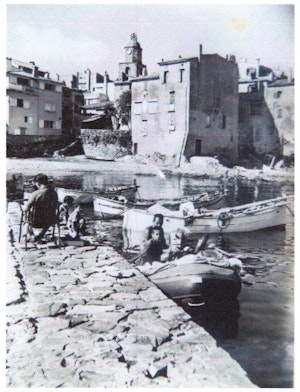Gwen Knight (1908-1974)
Untitled [Fishermen Sailing Boats and Row Boats]
Reproduced with the kind permission of Mrs Gabrielle Carmen Lees
Photograph B. de Lange, taken 1980s
Image taken from photographic transparency slide
This painting was exhibited and sold by John Leech Gallery, Remuera, Auckland, New Zealand, in the 1980s. Records of the work are unavailable.
This is a close view of La Pesquière, the fishermen's landing stage on the eastern side of Plage de la Ponche, the fishing harbour of St Tropez, France. Flora Scales in conversation with M. de Lange, 1984, said that Gwen Knight had also painted this scene which she vividly remembered. This is possibly the painting Scales was referring to.
Gwen Knight, Frances Hodgkins, Maude Burge and May Smith went to Ibiza at the end of 1932. Frances Hodgkins was there for six months, Gwen Knight stayed for six years.
BC018
St Maxime
[Sainte Maxime]
Seascape featuring row boats moored to left of landing stage and two beached row boats. Tree trunk to right encircled by green leaves and a vine. Water and hills upper third of painting.
LL blue brush point Flora Scales 1932 3
LL overpainted dark blue brush point Flora Scales 1932
LR scratched into ochre paint St [sic] Maxime
Verso (in Patience Tennent’s hand) St [sic] Maxime from St Tropez
Private Collection
New Zealand
Original owner Patience Tennent, the artist’s niece. First and second titles according to inscriptions. The second verso in Tennent’s hand recording information sent back to New Zealand with the painting. Third title, Overlooking Med Harbour, taken from the exhibition Flora Scales at The Suter Te Aratoi o Whakatū, Nelson, New Zealand, 2018.
The signature and date in blue brush point lower left appears to have been overpainted in a darker blue, possibly at a later date. The original date reads 1932 3. It is presumed this work was painted in 1932 in St Tropez, France, possibly under the instruction of E.D. Kinzinger.
This is a close view of La Pesquière, the fishermen's landing stage on the eastern side of Plage de la Ponche, the fishing harbour of St Tropez, France. The landing stage is also seen in Untitled [Mediterranean Scene] 2 [BC017]. Scales is painting from above the landing stage looking across the gulf to Ste Maxime which is directly north and twenty-five minutes by ferry from La Pesquière. Scales explained her choice of a high viewpoint in order: “to grasp the subject in one moment - the moment of seeing it and then, step-by-step, you see more, more is revealed.”
Letter from Hélène Riboty, Archives communales de Saint-Tropez, France, to Gérard Dubosson, researcher, Nelson, New Zealand, 03.04.2020, “[This] seems to me painted from one end of the place du révelin, one sees la plage de la ponche (and la pesquière) which was the port of the fishermen of Saint-Tropez.”
While in St Tropez, France, Scales met New Zealand artists Frances Hodgkins and Gwen Knight [see Timeline 1931]. Flora Scales in conversation with M. de Lange, 1984, said that Gwen Knight had also painted this scene which she vividly remembered. Gwen Knight, Frances Hodgkins, Maude Burge and May Smith went to Ibiza at the end of 1932. Frances Hodgkins was there for six months, Gwen Knight stayed for six years. Scales recalled, “There were men with their nets spread out to dry on a huge concrete landing stage. It was always draughty. There was a little beach and tall houses and a clothesline with sailors' trousers and a vine with bright green leaves. I sat with my work on my lap and my bag was beside me – cats played around me, jumping into my bag.”
Scales described the delight of travelling south to St Tropez by train in the 1930s to Linda Gill, 27.08.1976, “...most wonderful landscape…the farmhouses are pink and they rise straight out of the grapevines which are sometimes quite yellow.”
A few years earlier the English painter Vanessa Bell had also described the dramatic contrast between Northern Europe and the South of France, and the joy of living and working in the "Midi", in a letter to her sister, Virginia Woolf, 05.02.1927, “Painting is a different thing here from what it can be in the winter in England. It’s never dark even when the sky is grey. The light...is perfect and even now one could often work out of doors, if one wanted to. It makes such a difference to be sure one won’t be suddenly held up in the middle of something by fog or darkness. Also the beauty is a constant delight. The people are very friendly and helpful and living is very cheap...it seems more and more ridiculous for painters to spend half their lives in the dark.” – excerpt from Spalding, Frances, Vanessa Bell: Portrait of the Bloomsbury Artist, Tauris Parke Paperbacks, London, England, 2016, pg 216




